The seven-seater option is realistically a must for many families. Long gone are the days when all the children piled in to the back seat and the boot. With increased traffic on the roads and higher speeds, the safety of all the family is paramount. Everyone must be strapped in, and ISOFIX points are nearly a must for any family car. In rural Ireland, these types of cars are very popular on the school runs, where car pools with neighbours and families are common. The good news is that there is a fantastic selection of seven-seaters out now. Long-standing favourites such as the Ford Galaxy and Volkswagen Sharan are now joined by a long list. Here we look at seven options for seven seats in this growing market segment.
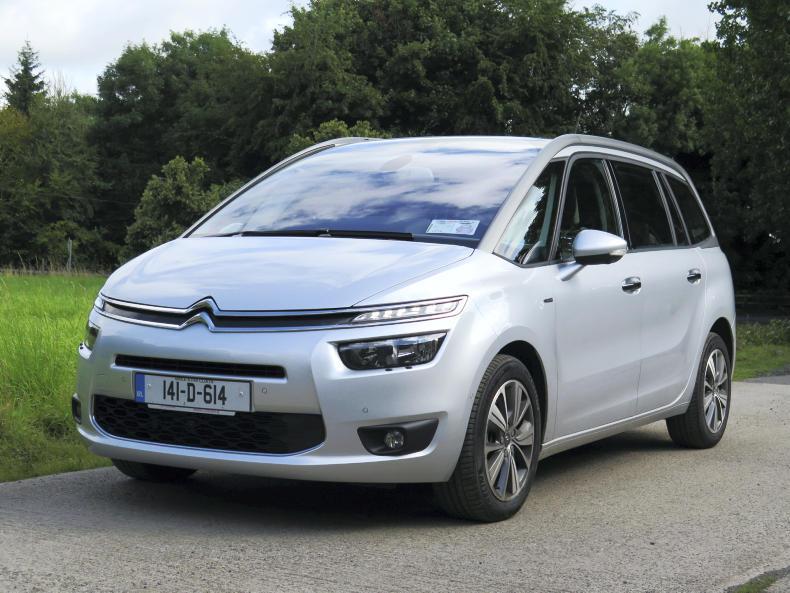
CITROËN C4 GRAND PICASSO
The Grand Picasso received another facelift in late 2016. The car is one of the most popular seven-seater options in Ireland. This is down to two reasons – it feels as roomy inside as some of the larger models in this class, while retaining a lower price, at €28,995 for the petrol model. Citroën’s PureTech petrol engine was named 2016 Engine of the Year in this class. Citroën says the engine has 120 patents to its name, and the three-cylinder Turbo PureTech petrol engine cutting fuel consumption and CO2 emissions by 18% compared with its four-cylinder petrol predecessor.
From an Irish motoring perspective, it Citroën’s 1.6 BlueHDI engines will be the most popular choice. The compact exterior dimensions of the new Citroën Grand C4 Picasso do not compromise in terms of space inside the car, with an overall length of 4.6m and a height of 1.6m making it ideal for ferry crossing on holidays.
From an outside styling perspective, as on the Citroën C4 Cactus, the New Citroën Grand C4 Picasso has a rear black chevron with chrome surrounding.
Using technology that creates a deep 3D effect, the eye-catching new rear lights are standard on the Grand Picasso. The Grand Picasso is available in three variants – Touch, Feel and Flair.
The entry level has quite a decent specification, with a 7in touchscreen display, 16in alloy wheels, rear parking sensors and driver attention alert.
The top-spec Grand Picasso model features, an automated boot, aircraft-style tables, keyless entry, park assist and much more. Prices start from €37,845 for the premium Flair models and €32,455 for the Feel model, which comes as standard with parking sensors, satellite navigation and a 12in touchscreen display. An automatic version with paddle shift is also on option.
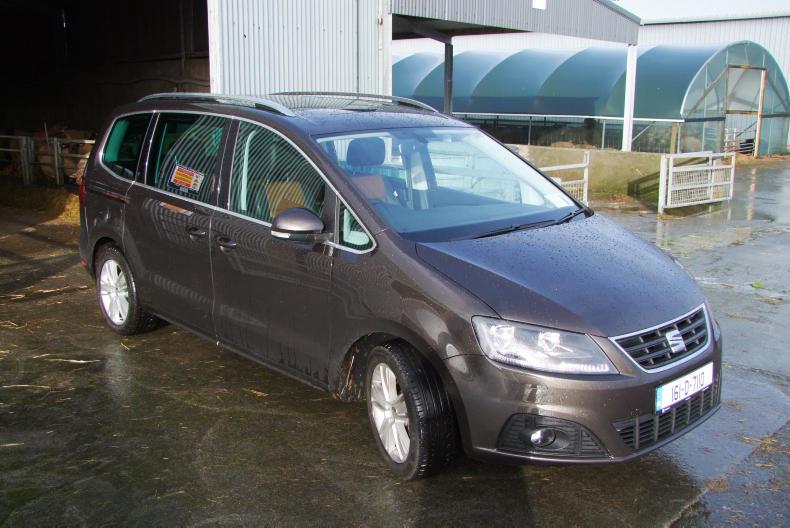
SEAT ALHAMBRA
The big people carrier option from Seat shares the same chassis and engine as Volkswagen’s Sharan and indeed the Ford Galaxy. In my view, these are the big three for the large family. Seat, as part of the Volkswagen family, ensures that the Alhambra shares a lot of the technical features as well as the performance of its near relation, the Sharan.
The Galaxy is the obvious competitor and so too is the largest volume seller in this segment, the slightly smaller and far more price-competitive Peugeot 5008. With its relatively competitive pricing, the Alhambra is marginally behind the Ford in the sales charts. What might tip the scales in the Seat’s favour is the good towing ability, which at 2.4t with a braked trailer is the best in the class. It also has an impressive safety package, with ISOFIX in the rear and seven airbags, but its Euro NCAP rating is slightly dated. The Seat styling is modern and impressive. This is a people carrier that looks well and functions in a practical sort of way, with twin sliding rear doors and foldable middle and rear seats. It is 1.9m wide on the road nearly some 10cm wider than some of the competition. What is really noticeable is that with the full seven seats in use, there is still 300l of boot space, with some smaller seven-seaters this space disappears. Another huge plus is the 2.0l TDI Volkswagen engine that is frugal and powerful with the 150bhp version.
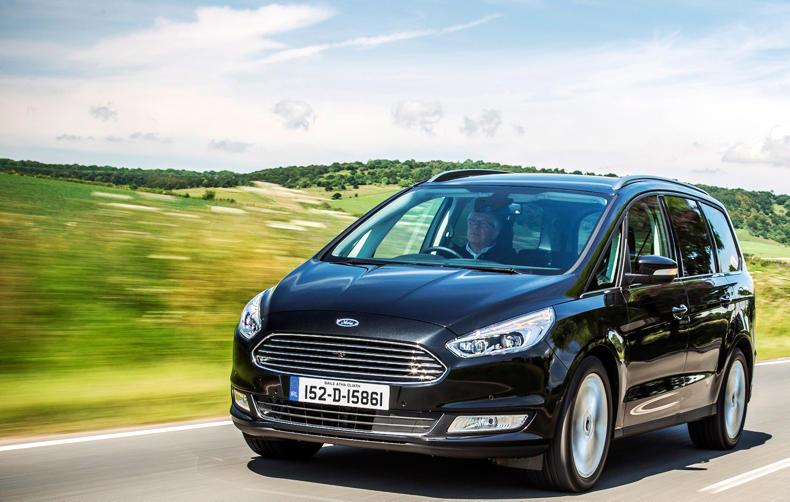
THE FORD GALAXY
Ford is at the top of the market with a 40% share when it comes to people carriers. That should be no surprise with what the Galaxy and S-Max have to offer along with the smaller Grand C-Max. The Galaxy comes with three diesel engine options, all based on a 2.0 litre turbo-diesel unit that has been upgraded for better economy.
Power options range from 120bhp to the massive 180bhp version. The Galaxy’s main competitors are its nearest relations – the Volkswagen Sharan and Seat Alhambra. The big three share the same platform and engines. The Ford has a sportier feel to it. There are lots of storage spaces in the Galaxy – handy for families who are always bringing lots of kit on board. The front legroom is generous and there is impressive room in the second row of seats that can be moved and altered to suit different needs. This is a three-row people carrier and, even with the third row of seats in use, there is impressive boot space. The third row of seats folds flat to the floor with ease for the extra loads. The Galaxy is not a sliding door people carrier. The doors are big and open wide and, with a car as big as this, you need to pick your parking spaces carefully. Ford’s automated parking system (€250 extra) could be a very useful investment. The system allows parallel and perpendicular parking.
Ford offers a wide specification choice, but the base specification is good, with parking sensors, mini spare wheel under the boot and alloy wheels to name but a few items.
The base car has plenty of safety kit and is child friendly, with two ISOFIX couplings in the second row of seats. The Euro NCAP safety rating is recent and impressive at five stars. There is a significant gap between the entry-level Zetec at €38,860 and the 180bhp Titanium version at €47,535.
VOLKSWAGEN TOURAN
For the Irish market, Volkswagen offers the Touran as a seven-seater only. This latest generation model has been heavily revised, not only in terms of styling, but it has also grown significantly, while it is 62kg lighter. Volkswagen says it is 130mm longer, 41mm wider and has a 113mm longer wheelbase than the previous model. The car sits lower to the ground than before and Volkswagen is claiming a 19% better fuel economy as a result, depending on the model chosen. There is a choice of three engines – two diesels and one petrol. The entry level 1.6-litre 110bhp (250Nm of torque) diesel is likely to be the largest seller and this comes with a choice of six-speed manual or seven-speed DSG automatic. The manual version comes with fuel economy figures of 22.7km/litre (4.4 litres/100km) and 116g/km CO2. The DSG version is claimed to be even more frugal.
The Touran offers 743 litres of boot space with the third row folded down and two occupied seat rows. To stop luggage sliding around, the Touran comes as standard with a fixing element and tensioning strap to secure the load. An optional extra is the Easy Open for the boot. The system detects the car key in your pocket as soon as you approach the Touran. You open the rear lid with a slow kicking motion under the rear end of the vehicle. It will then open far enough for you to put your things inside. The base level Trendline specification, rises up to the Comfortline and then the Highline.
In my view the Touran is ideally suited to the family with three kids, who have the option to carry more passengers with the pull-up third row of seats. The Touran starts at €30,820 for the petrol version, and €33,090 for the entry-level diesel with a manual six-speed gearbox. The top-spec Highline model with 150 bhp and the DSG gearbox comes in at €41,850.
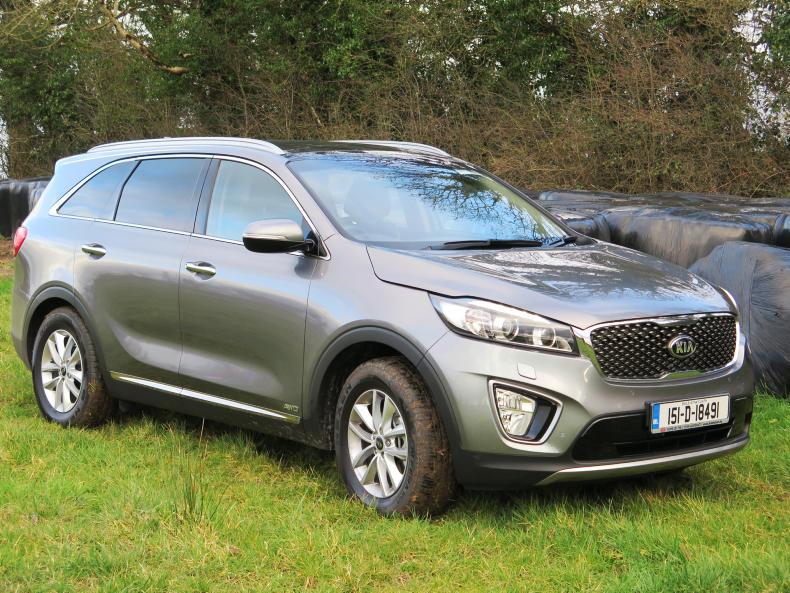
THE NEW SKODA KODIAQ
Škoda Ireland revealed Irish pricing and specification details for its new five- and seven-seat Kodiaq SUV, with prices starting from a competitive €28,795.?
The Škoda Kodiaq will launch in Ireland in March with three trim levels (Active, Ambition and Style), five engine and transmission options and 14 different exterior colour options. A seven-seater option will also be available for just €1,000 more than the standard five-seat model.
That entry level Active trim level includes a host of impressive features, including 17in Ratikon alloys, Cruise Control, Bluetooth, Climatronic air conditioning and the clever Smartlink+ technology for smartphone integration with the infotainment system. The Ambition trim level offers a host of additional features such as 18in Triton alloys, keyless engine start, silver roof rails and front and rear parking sensors. The top of the range style trim level includes additional features such as 19in Triglav alloys, keyless car unlock and keyless engine start, full LED headlights, Alcantara upholstery, interior ambient lighting, a rear-view camera and 8in Columbus navigation system.
Cathal Kealey, PR manager at Škoda Ireland, said: “We have seen unprecedented interest in the new Kodiaq and with the competitive prices and impressive specification announced today we are confident that customers won’t be disappointed. If customers would like to see this impressive new SUV in dealerships before it goes on sale in March, they can visit www.skoda.ie and check out where this car will be available to view over the coming weeks.”
The Škoda Kodiaq comes with a host of connectivity features such as Smartlink+, the smartphone integration system containing Apple Car Play and Google Android Auto which is available as standard on all models.
The Columbus navigation and infotainment system which is standard on the Style trimline also comes with an additional 4G LTE sim card slot to enable a high-speed wifi hotspot within the car (data plans sold separately) and a host of additional connected services from Škoda Connect. Škoda Connect Mobile Online Services offers enhanced real-time route planning, real-time parking and petrol prices in the locality, customisable newsfeed, weather, customisable points of interest, in addition to other online services.
A second Škoda Connect solution which is also standard on all trimlines offers additional functionality like remote access to the vehicle via the new Škoda Connect mobile app in addition to a number of additional driver assistance solutions.
One such driver assistance feature is the Emergency Call (e-Call) function which will automatically call the emergency services once an airbag is activated to further improve occupant safety.
KIA SORENTO
The Sorento is a seven-seat 4x4, with a 2.2-litre turbo-diesel engine that remains largely unchanged. Kia uses a part-time 4x4 all-wheel drive (AWD) system, which pushes all of the engine power to the front wheels until one of them slips, when it instantly splits the power and sends up to 40% of the engine power to the rear wheels to give the driver greater four-wheel-drive stability. Kia has shaved the CO2 levels to give a road tax cost of €390, which is good for an SUV of this size. It is selling the Sorento primarily as a seven-seat SUV. The third row of seats are tight, and more suited to acrobatic kids, than adults. The second row of seats folds on a single-lever operation to give access to this third row.
The electric opening kit on the Platinum models should be a very useful, with hands often full with small kids. The large-screen satnav is easy to use and doubles to give a big screen for the reversing camera. The Sorento has the maximum five-star crash safety rating from Euro NCAP. It comes with a vehicle stability management (VSM) system as standard as well as electronic stability control (ESC). There are extra safety features available – more for additional driver support than totally necessary with such an impressive international safety rating. The entry price of the seven-seat Platinum version is €43,995. The other important Kia bonus is the seven-year warranty, but it’s limited to 150,000km, which may or may not be an issue for some drivers
HYUNDAI SANTA FE
The latest-generation Hyundai Santa Fe comes packed with some useful driver features that give it a specification that’s a match for some of the larger SUVs.
The Santa Fe’s towing rating of 2.5t puts it down the field, in the same category as the related Kia Sorento, Nissan X-Trail and the new Ford Edge in terms of size and engine performance. They are fair comparisons and ones not to feel bad about, as the Hyundai Santa Fe, with a 4x4 all-wheel-drive (AWD), can meet the needs of many SUV buyers. This is a large SUV in terms of appearance, while still tidy on the road and marginally more muscular than the company’s best-selling Tucson.
The seven-seat capacity makes it more of a family car than any SUV workhorse. There is ample space, with reasonable comfort for short journeys in the third row of seats. The second and third rows can be folded to give a flat floor area. With all seven seats in use, boot space is restricted, but that’s what you can expect from an SUV of this size. The rated fuel economy figure from what is a sizeable SUV is reasonable at 15.2km/litre (6.6/100km or 42mpg). The Santa Fe is almost 400kg heavier than most other SUV’s in this class. The appealing features include hill descent control and a centre differential locking system that, other than when in the hands of serious off-road users, will probably rarely be used. The lane departure system, which is also part of the safety kit, will probably get more use, although some drivers find these systems annoying, especially in rural roads where the centre white line is used with sense. The Santa Fe is well equipped in terms of safety features, with ISOFIX on five of the seven seats. That makes it family-friendly and the five-star Euro NCAP rating confirms that. There’s a spare wheel in the boot and that’s also a useful feature for rural drivers.
Prices start at €41,995 so it’s not cheap, but it is very stylish.

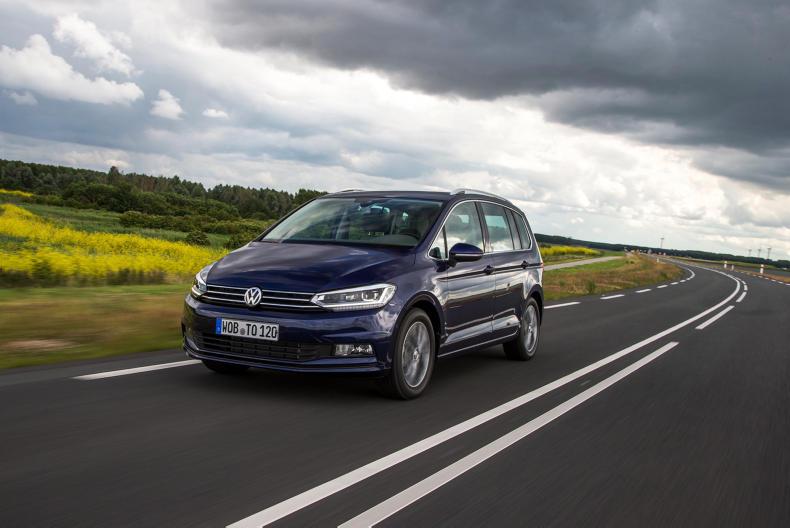




 This is a subscriber-only article
This is a subscriber-only article















SHARING OPTIONS: